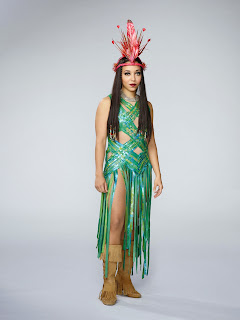Cher Tiger Lily (Pan 2015)
Yesterday I watched the trailer for the 2015 movie Pan, and I blogged about the new adaptation's portrayal of Captain Hook. But I've never discussed the treatments of Tiger Lily in the various TV and film versions.
Tiger Lily is the princess of the Piccaninny Tribe of Indians living on the island of Neverland. Probably the most well known image of her comes from the 1953 Disney movie:
Although her appearance is not particularly offensive, the treatment of Indians in this film has been long criticized, due to the song "What Makes the Red Man Red?" and the Indians' exaggerated features, which makes them look like caricatures and affirms the sterotypical view of this people:
But that's no newsflash.
It's interesting that the Mary Martin version features a Tiger Lily whose appearance is the polar opposite. This Tiger Lily is not offensive because she promotes stereotypes or the sexualization of Native American women (we're looking at YOU, Disney Princess Pocahontas!). No, it's offensive, and utterly confusing, because she looks like the Swiss Miss girl.
Rayna Green writes in her article “The Pocahontas Perplex: The Image of Indian Women in American Culture.” that the white appearance of Pocahontas in various renderings relates to the concept of the “Indian Princess,” an American figure that serves to represent America and its values (702-703). The Indian Princess is not rendered like other Natives. Green describes, “The Princess is ‘civilized’; to illustrate her native nobility, most pictures portray her as white” (704).
When Cathy Rigby played Peter Pan on Broadway and in a televised performance, Tiger Lily did look a little less Anglicized. However, her costume resembled the Disney's Pocahontas rather than Disney's Tiger Lily.
The 1991 movie Hook took the easy way out, and declined to portray Tiger Lily or any Indians at all.
Personally, I feel that the most socially responsible representation of Tiger Lily is Carsen Gray's portrayal of her in the 2003 film Peter Pan.
Gray descended from the Haida, indigenous people of the Pacific Northwest Coast of North America. In the film, she speaks the Iroquois language, in contrast to previous Tiger Lily's who didn't speak at all (Disney 1953), or spoke English mixed with gibberish
(uu-a-wuug and puff-a-wuff and gugg-a-bluck aren't real words).
A Native American actress, speaking an actual Native American language!
Who would've though it could work?!
Last year, NBC broadcast a live teleplay of Peter Pan, notable because Christopher Walken portrayed Captain Hook. Playing Tiger Lily was actress Alanna Saunders, whose paternal great-grandmother was part of the Cherokee Nation.
This version changed the nonsensical lyrics to the Ugg a Wugg song and titled it "True Blood Brothers". The production had a Native American consultant who helped create something 'traditionally Native American'. I'm glad he helped with the song, but I'm assuming they didn't run Tiger Lily's costume by him:
The costume's actually not the skimpiest one ever, but the shiny turquoise streamers don't exactly scream 'traditional.'
Unfortunately, it seems now that the film industry has regressed to mid 20th century values, because in Pan, Tiger Lily is once again blonde.
Furthermore, she also appears to be cast as the males' plaything, an exotic beauty who is a trophy from a far away land.
Does this seem familiar?
And on a less depressing note, writing this post prompted me to look up a biography on Cher. Apparently, her mother was of Cherokee ancestry.
She can't turn back time, but apparently Warner Brothers Co. can.













No comments:
Post a Comment